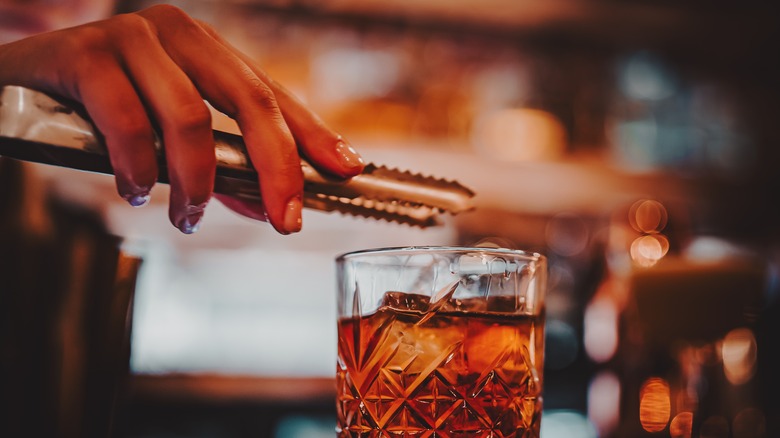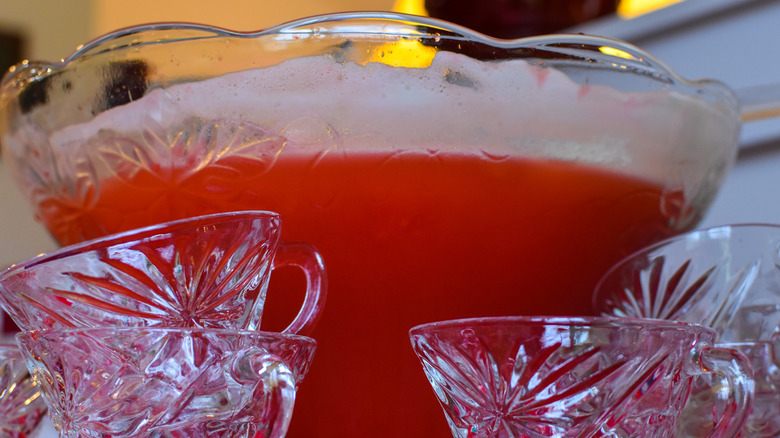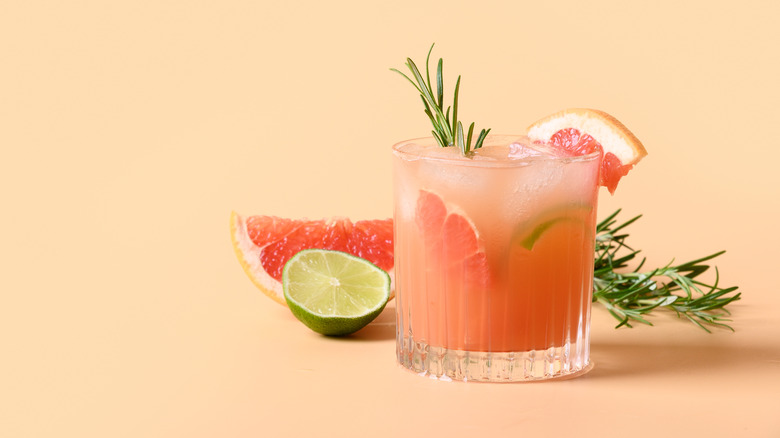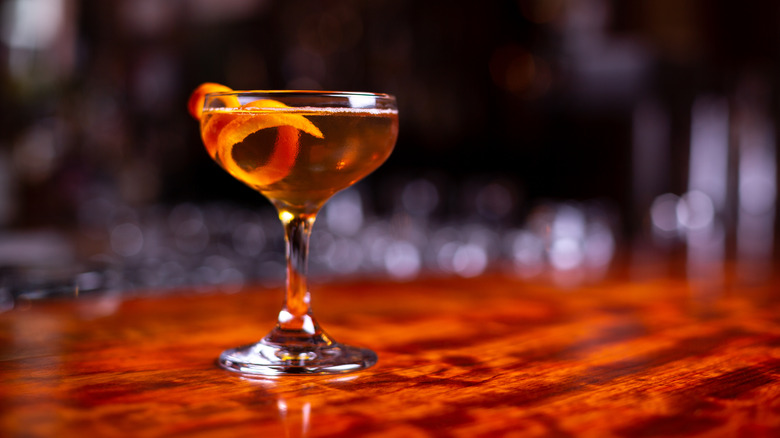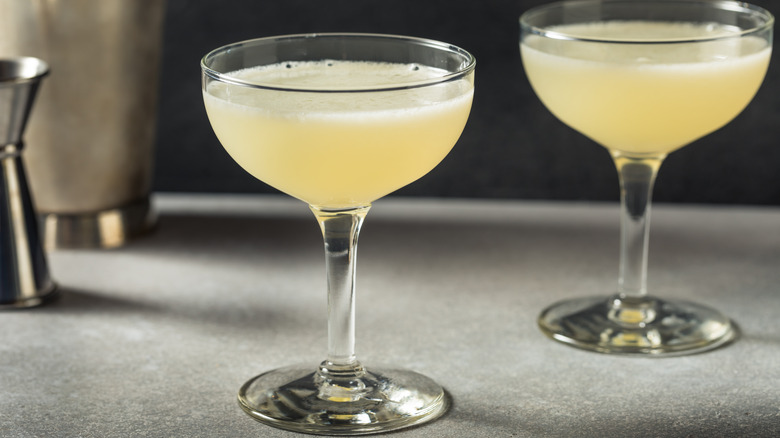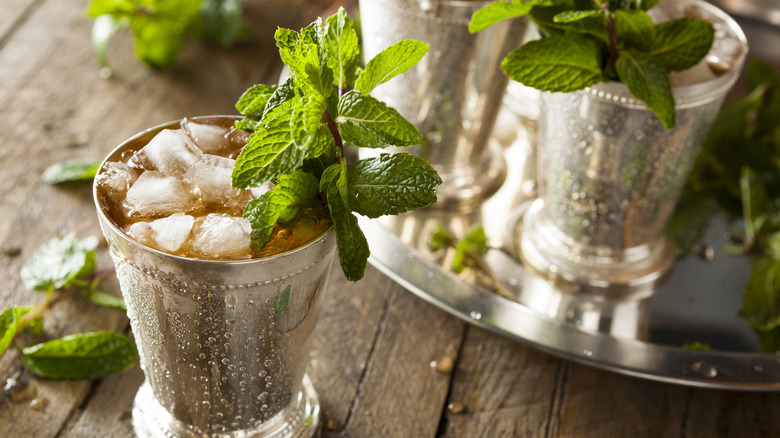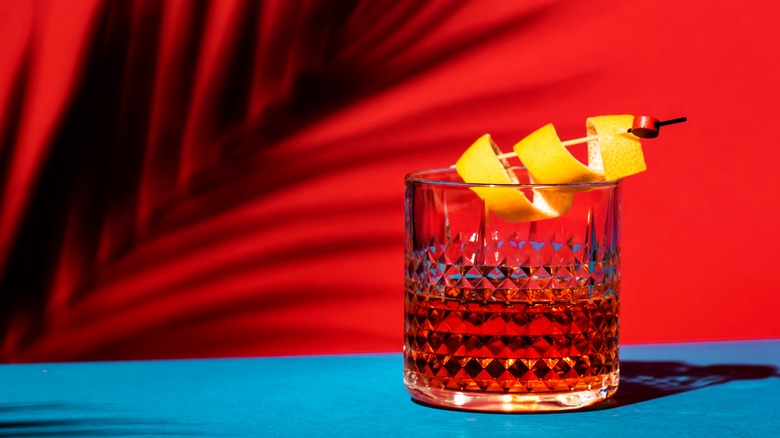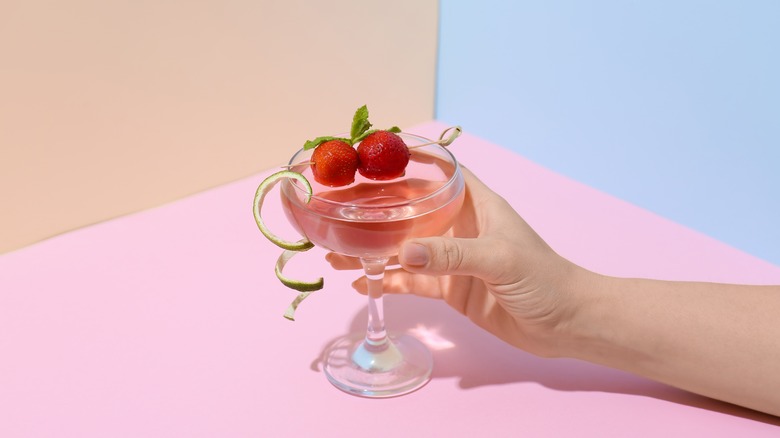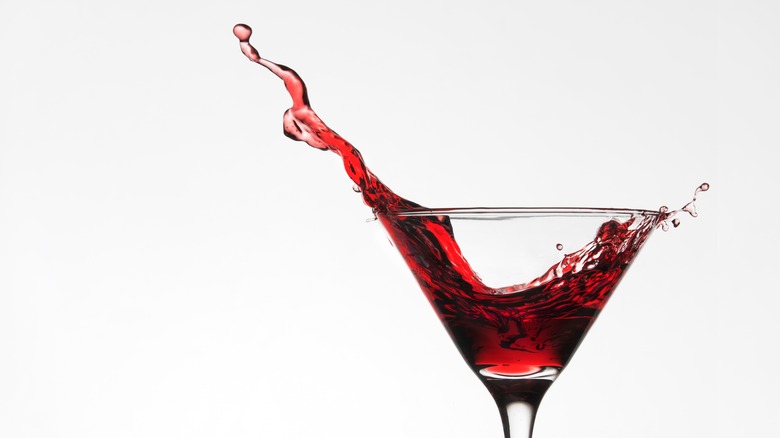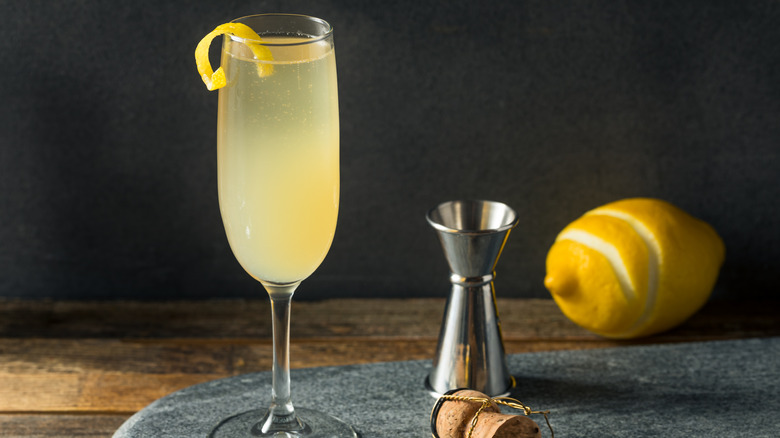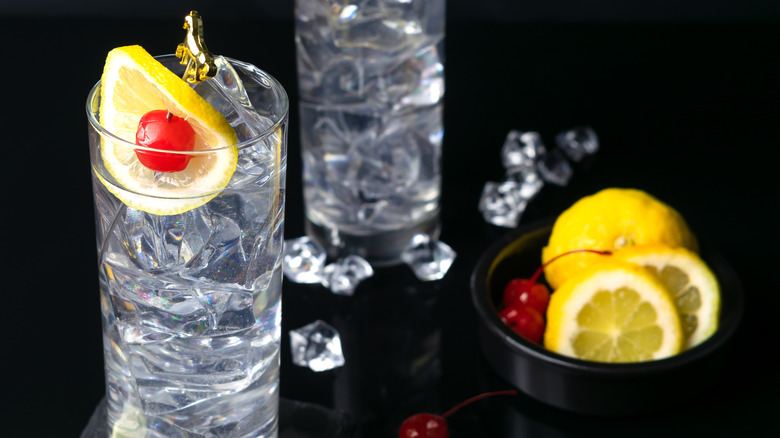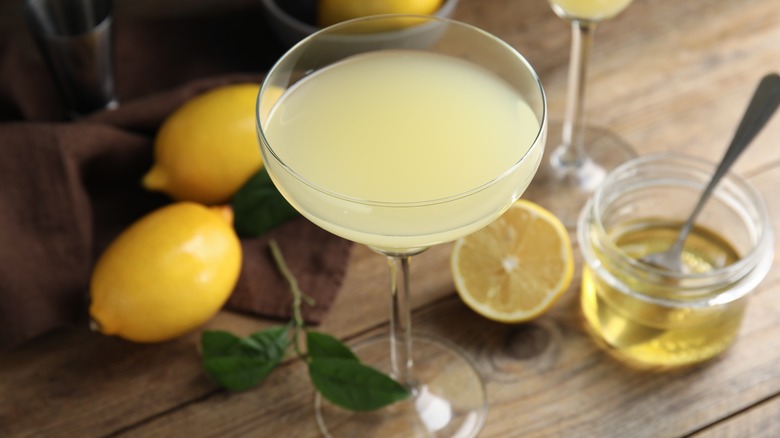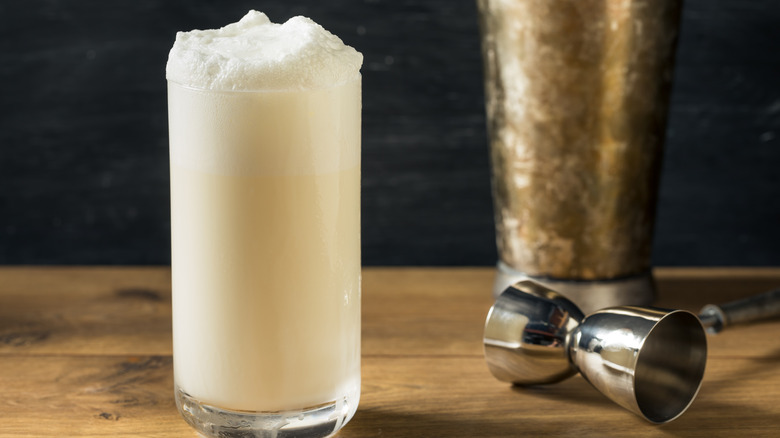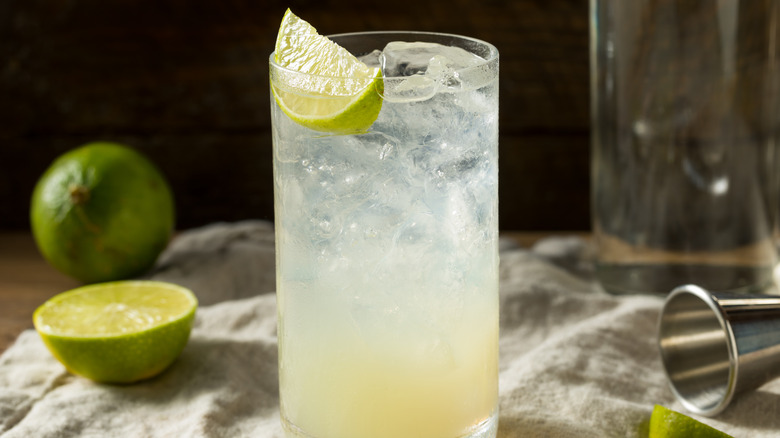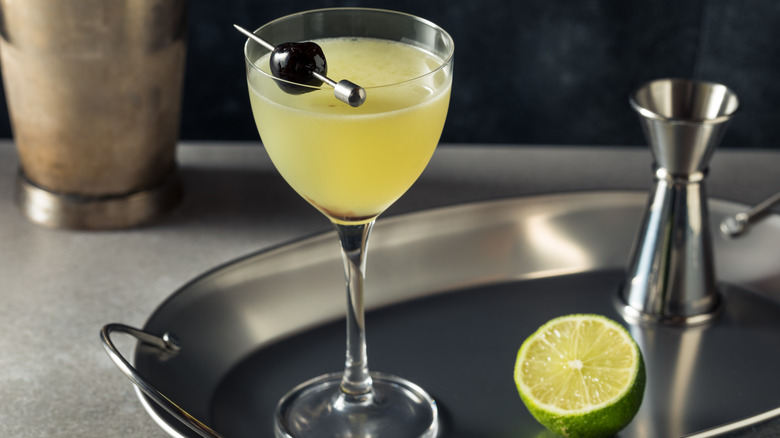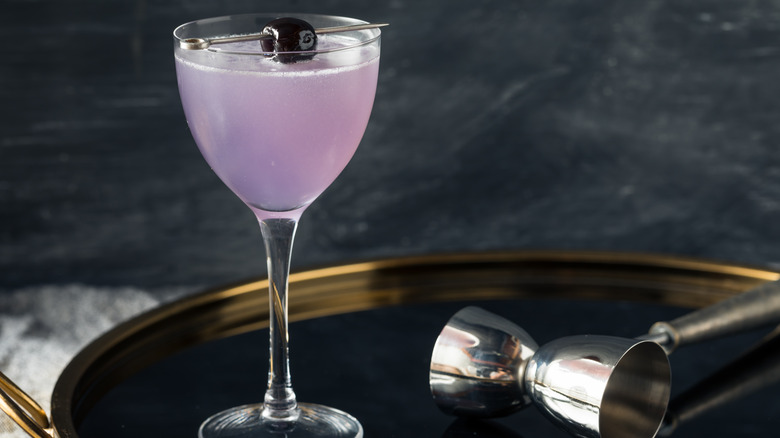16 Old-School Cocktails In Need Of A Comeback
It might seem like cocktails have been around forever, but they're a relatively modern novelty, only dating back to the 18th century. It's hard to pin down who and what exactly made modern cocktails "modern." Some drink historians look at the 19th century as a pivotal point for the now-beloved drink. It took until the 21st century for cocktails to be defined, according to The Cocktail Society, as a balancing act between boozy, sweet, and bitter, with water added in at times to achieve the desired effect. It doesn't sound too far off from the way cocktails are served up nowadays, nearly 200 years later!
According to Difford's Guide, other important moments for the cocktail were the creation of portable ice, the streamlined process of continuous distillation, and the manufacturing of carbon water. This allowed for cooled, fizzy refreshments and spirits available en masse. The guide observes that American bars particularly took a shine to cocktails and makes the argument that the modern cocktail really can be understood as a red, white, and blue innovation. It's good to know that even in the bar, we can come face-to-face with history and good ol' American ingenuity — quite literally. So, kick back and get inspired: These are 16 classic cocktails that are long overdue for a comeback.
Fish House Punch
There's no better way to imbibe in some United States history than perhaps with a Fish House Punch, a boozy bevvy that claims George Washington himself among its many connoisseurs, according to Atlas Obscura. The punch is quite literally older than the country itself, and the first mention of it can be found in 1732. It was created at the oldest clubhouse in the U.S., The Fish House, and its exact recipe remained a tight-lipped secret for a very long time.
Even nowadays, there's a lot of variation on how to best make Fish House Punch. Really, the consensus is to mix with grandeur and gusto: Fizzy wine, fizzy water, rum, cognac, orange pekoe tea, peach schnapps, sugar, water, pineapple, bourbon, and Champagne are all elements that can be combined to make this fierce mixture. If Fish House Punch should be one thing, it should be, above all else, strong. The punch is traditionally accompanied by an extremely large block of ice, weighing in at around four pounds, in the middle to chill the chaos. One final consensus when it comes to the Fish House recipe is that it should never be served with whiskey as that "was looked upon as the drink of a groom and not of a gentleman," according to The Wall Street Journal.
Greyhound
The greyhound cocktail is the potent and passionate communion of grapefruit and vodka. While its salmon pink presentation may scream trendy, the cocktail got its recorded start back in the '30s, according to Ramshackle Pantry. That's not to say it wasn't hyped: Back then, grapefruits were all the rage. Who would've guessed that the potently tart citrus fruit was the avocado of another generation? It's interesting to note that during Prohibition, many bartenders turned to Europe and even American-style bars in Europe to serve up drinks. Thus, the greyhound officially got its start overseas, though its roots may be nonetheless in the States.
Though primarily a vodka cocktail nowadays, this drink wasn't originally served with that booze but with gin. As Ramshackle Pantry observes, gin was the alcohol du jour back in the day. Perhaps the popularity of the two ingredients is what drove them to marriage, but it was, at least according to the food website, vodka's meteoric rise to fame that led to the cocktail's second marriage. Nowadays, it really does boil down to taste when ordering a greyhound. While vodka may be the fallback for this cocktail, with the reemergence of gin in pop culture, maybe the OG greyhound will soon be rearing its head again. In the meantime, there are plenty of recipes to scratch any itch, like the one from Tasting Table that innovatively suggests brûléeing grapefruits before juicing them to give the cocktail an unexpected smoky twist.
Sidecar
The name "sidecar" has very little to do with the drink itself and more with its origins. Well ... allegedly. An entry in Difford's Guide claims the name owes itself to the cocktail's alleged creator, who would often ride sidecar on motorcycles. It's said that the cocktail was first conceived abroad during Prohibition, albeit in an American-style cocktail bar. Though there is a bit of drama that the supposed contemporary of this mixologist actually laid claim to the drink, there are certain things that do not waiver, and that's what makes this classic cocktail last through the ages.
Sidecars are a thrilling combination of cognac, triple sec, orange liqueur, and a twist of lemon juice to nail the landing. Chilled Magazine romantically describes the cocktail as a "rich honey-colored drink," which is sure to add both some color and relief during those hot summer nights. As the latter magazine notes, sidecars most likely come from the older "Brandy Crusta" cocktail, to which it still bears a striking resemblance, but it's safe to say that the sidecar has come to ride all by itself.
Corpse reviver no. 2
The corpse reviver no. 2 is anything but subtle. It was at one point considered a mean hangover cure, according to the Phoenix New Times. When looking at the cocktail, it's hard to believe it could be described so potently: Its pale yet bright yellow color and delicate garnish come off as chic, not threatening.
Just one look at the historical recipe provided by Difford's Guide is enough to confirm how this drink could shake life back into just about anything: a glass mixed with one-part lemon juice, Lillet Blanc, Cointreau, dry gin, and a dash or rinse of absinthe. While absinthe may not be the prescribed antidote for a hangover, the corpse reviver no. 2 remains, according to the Phoenix New Times, the most illustrious member of the corpse reviver family. The article notes the drink can be served as an especially spooky cocktail for Halloween. But, the ever-strong corpse reviver no. 2 fares just as well on those days (and nights!) that need more than a little kick.
Mint julep
Mint juleps are a southern staple synonymous with the Kentucky Derby, where a mind-boggling 120,000 mint juleps are served on average, according to Town and Country. The name "julep" actually refers to "julab," a Middle Eastern drink that mixes water with rose petals. It's thought, according to the magazine, that this drink eventually made its way to the Mediterranean, where the rose petals were replaced with mint. This is where the American mint julep cocktail takes inspiration and utilizes (fresh) mint leaves, simple syrup, bourbon, and lots of crushed ice.
It's not quite clear just when and why the mint julep made it to the U.S. According to The Atlantic, it was made the official drink of the Kentucky Derby in 1938. Ice is an important factor in beating the heat, as is holding it right: "Julep cups should only be held by the top or the bottom so that the crushed ice inside them can create a frost on the outside."
Sazerac
Another southern wonder, the Sazerac might be a bit more obscure than the mint julep, but that doesn't make this drink any less appetizing. The Sazerac traces its roots down to New Orleans, where the cocktail was first conceived in an apothecary, according to the official New Orleans tourism website. The site claims that the drink's name comes from the mixologist's favorite brandy, Sazerac-de-Forge et fils. The liquor then came into contact with bitters and sugars, resulting in the potent cocktail. While the recipe's brandy has long been substituted for the more down-home whiskey, the Sazerac remains decidedly New Orleans in nature, partially due to the dash of absinthe that was added late into the 19th century.
While this is certainly not the easiest drink for cocktail newbies, it remains lauded by Imbibe Magazine as a notable member of the classic cocktail family. Though the original apothecary where the first Sazerac was conceived has long since been destroyed and replaced, the recipe persists. In New Orleans, one can still find a good Sazerac easily. Among the veritable sea of bars, one Yelp reviewer pointed out Bar Tonique, once visited by chef Anthony Bourdain, as having "the best Sazerac in the quarter."
Cosmopolitan
A modern classic, at least according to Punch Drink, it's hard to separate cosmopolitans from Carrie Bradshaw. But it's worth taking a look at the viral drink behind the viral show. You can't ignore the cosmo: its iconic color, its unique sweet-yet-tart flavor, and its presentation in a classy martini glass. The cocktail first got its start in San Francisco, where it began as a sort of Kamikaze variant with a dash of cranberry juice to beautify it. The drink soon made its way over to the East Coast and arguably found its home there.
Refinery29 and Punch Drink credit the modern iteration of the cosmo to mixologist Toby Cecchini, who took the bare bones of the recipe and heightened it with Cointreau, Absolut Citron, and fresh lime juice. It took the good-looking drink and added a good-looking taste. While the drink's heydays in the late '80s and early '90s have long passed, and its revival on-screen has landed it in the annals of pop culture history, there are signs of a comeback, according to Refinery29.
Martinez
No, not the martini, the Martinez. This classic cocktail is considered to have had a big influence on the martini, according to Spirits Beacon. But, as Difford's Guide points out, when looking at lineage, it becomes clear that the Martinez itself evolved from the Manhattan. So, the Manhattan led to the Martinez, which led to the martini. If that wasn't confusing enough, there's both a dry and sweet version of the Manhattan. But the first readily available recipe for the classic Martinez gave no clear direction as to how it should be prepared (via Spirits Beacon). This has since led to two schools of thought when preparing this classic cocktail: the dry or sweet Martinez.
A Martinez cocktail is at its best and brightest when balanced. The drink calls for gin, vermouth, bitters, and orange Curaçao, which lends to a bold taste and color. It's really the vermouth that brings the drink into two houses. The aforementioned guide recommends an Italian vermouth for a sweet finish and a French vermouth for a dry one. It also observes that sweet finishes have long been out of trend, and one is much more likely to encounter a sweet Martinez. Another matter of taste lies in the gin: For those preferring a lighter, clearer finish, opt for English gin. For those who prefer tradition, look no further than Dutch jenever, a heavier, maltier liquor that once was used to whip up this concoction regularly.
French 75
The French 75 might be on the cusp of a renaissance. This fizzy drink first got its start after World War I. It was named after the French cannon that was helping hold the country's offensive against Prussia. So, it comes as no surprise that this cocktail carries a special sort of hit to it. Indeed, this cocktail is a gin-based Champagne cocktail. While the thought of pouring gin into Champagne might be off-putting, don't walk away just yet.
The French 75 is a simple yet complex cocktail where gin is shaken together with lemon and a little sweetener, then topped with a bit of the bubbly. As one recipe from Tasting Table observes, the shaken gin does a lot to ease its potency. Not to mention, the bright yellow of the cocktail is invitingly warm. In an ode to the French 75, one admirer from The New York Times said the cocktail is "full-proof" and can adjust to any dinner party's needs. Whether as a nonalcoholic or low-alcohol content drink, even with cognac substituted for gin, the French 75 is a reason to celebrate in itself.
Tom Collins
Like a lot of good things in life, the Tom Collins cocktail started with a joke. Around the late 19th century, it became a prank, especially in New York, to convince someone that "Tom Collins" was spreading rumors about them. Eventually, the social industry caught on, and thus, the tongue-in-cheek Tom Collins cocktail found its name. It's almost a bit of a relief to have an absurdly common name in a sea of extravagantly named gin drinks.
The cocktail in and of itself is easy enough to make and even easier to order! A Tom Collins cocktail was classically made with a bit of lemon, gum syrup, and ice shaken together. A bit of sparkling water animated that entire affair, according to Icon. These days, the drink is generally served in a tall tumbler with the same structural components, albeit most likely a different sweetener, and is served with a flair of lemon, orange, and cherry garnishes. Times change, and the ingredients may change slightly, but the good humor is eternal.
The Bronx
First coming to the bar around the end of the 19th century, according to Difford's Guide, the Bronx belongs to the series of cocktails named after New York City's esteemed boroughs. Surely, the Bronx is not as famous as its sister cocktail, the Manhattan, but this wallflower still has a lot of strong suits that might otherwise go unnoticed. The orange cocktail uses both sweet and dry vermouth of equal quality and pairs it with gin, orange juice, and bitters.
The outlet argues that the orange juice is really what gives this cocktail a summery quality and could even make an excellent contender for those who have had their fill of bottomless mimosas. Liquor.com argues that this drink isn't about complexity but rather about quality: It recommends using fresh orange juice to make a more vibrant and refreshing refreshment. It also notes that gins with a citrus base, like Hendrick's Gin, will only bring out the best in this already great cocktail. At the end of the day, the Bronx is a pretty cocktail with a pretty flavor under the right conditions.
Bee's knees
The bee's knees is a mix of lemon, honey, orange juice, and, for the buzz, gin, as Difford's Guide explains. Always shaken and sometimes given an orange zest garnish, this smooth yet zesty cocktail is a classic that should not be left to the annals of time. Despite its alleged Parisian roots, the bee's knees is believed to have made it stateside during Prohibition, when the recipe's honey and juices would mask the bad taste of homemade gin, according to the outlet.
As Spirits Beacons advises, do not pair the bee's knees with sweet or fruit-infused gin, or it will tip this already sweet cocktail into sickly sweet territory. On the other hand, as per the site, camomile or herb-infused gins will add a wonderful and fresh dimension to the drink. The site offers up one more piece of advice: Honey either makes or breaks this cocktail, so make sure to find high-quality honey! As Difford's Guide clarifies in their recipe, make sure to shake raw honey with the juices before shaking in gin. This will keep the bee's knees buzzing.
Ramos gin fizz
The Ramos gin fizz is a cocktail that was conceived in New Orleans and is always shaken — never stirred. This drink is easy to spot across the bar: It's creamy in color and topped with a cloudy foam head. It's a true beauty but hard to find outside of NOLA. There's no one real reason why this drink hasn't made it out of city limits, but there is a lot of speculation. One of the main theories for its obscurity is the long list of ingredients needed to whip it up: Gin is paired with heavy cream, lemon and lime juice, simple syrup, soda water, a bit of orange blossom water, and egg whites to achieve its foamy look, though gin fizzes can be made without egg whites. That's certainly a lot for a bar to carry in order to make one drink! But, the result is one of a kind. The gin fizz's taste is described as a refreshing mix of creamy and citrusy, with a frothy temperature that's sure to soothe even the most parched.
The level of frothiness that a Ramos gin fizz demands requires elbow grease. Traditionally, the cocktails would be shaken for 12 to 15 seconds, but one bartender quoted by Liquor.com argues that a good Ramos gin fizz can be shaken for around 25 seconds, 45 seconds if the bartender wants to put on a show. It is nonetheless worth the work.
Gin rickey
The gin rickey remains the capital of the nation's capital and a much-celebrated cocktail unique to the District of Columbia. Legend has it the cocktail was created in the late 19th century to combat the characteristically humid mid-Atlantic summer. While originally made with rye, the gin rickey overtook the original whiskey-rye rickey. The reason for the shift from rye to gin was partially due to a general change in taste around the 1890s, which, according to Inside Hook, shifted Americans increasingly from the traditional Irish, Scottish, or American whiskey over to gin. This was further cemented by Prohibition, which saw the rise of "bathtub gin" which could be produced easily and delivered readily. Gin was cemented as alcohol du jour, and thus, the gin rickey took over.
According to Imbibe, the gin rickey is made with gin, of course, freshly squeezed lime, and soda water. It's always served on ice. As Inside Hook writes, the gin rickey has become D.C.'s most emblematic cocktail. While the rest of the country may not know this drink by name, the city holds it dearly. This affection is probably best illustrated by the city's annual gin rickey contest, which has sought to find the city's best gin rickey for the last 12 years.
The last word
The last word is a classic story of balance. It's made with gin, green Chartreuse, lime juice, and maraschino liqueur in the perfect ratio, as Punch Drink notes. The flavors that define this cocktail are big and need to be in perfect harmony for the last word to be palatable. Green Chartreuse is herbaceous, Punch Drink says, the lime juice is zesty, the liquor sweet, and the gin dry. When it works, it is a feat of great mixing. The last word isn't for the meek — it's for risk-takers who delight in big payoffs. Some may even be surprised at just how refreshing this drink can be.
While not quite in the mainstream, the last word saw a revival in Seattle, perhaps because of the challenge for both those behind and in front of the bar. The Seattle Times proclaims that this drink is not easily palatable and comes off as "a shock, but a pleasant shock" to those bold enough to drink it. It takes some time to grow accustomed to the charms of the last word, but that's all a part of the appeal. While there have been many variations of this classic cocktail, The Seattle Times claims that what makes the last word so fascinating is the fact that it's so unique. Indeed, for ardent admirers, the last word has the last laugh.
Aviation
The aviation cocktail — not to be confused with Aviation Gin — is an enchanting lavender mix that makes a breezy companion to humid summer nights. Crème de violette liqueur is responsible for the drink's iconic color and also for its relative obscurity (via Liquor.com). Despite its name, the drink actually contains no cream and is instead made by liquefying violet flowers in brandy or a neutral liqueur (via Taste Atlas). This gives the purple liquor a distinct floral flavor with what the outlet describes as "fruity" notes and a "smooth" finish. The aviation cocktail utilizes crème de violette's unique taste and stunning color. It's traditionally mixed with gin, maraschino, and freshly squeezed lemon. This makes for a really well-balanced cocktail with floral and fruity notes and a refreshing twist of lemon.
Do heed this warning, though, as the profile from Liquor.com suggests, be careful when mixing in the crème de violette, as it has the potential to overwhelm the recipe and make it too floral. While the violet-based liquor all but disappeared by the mid-20th century (and the cocktail with it), it has seen a slight resurgence since the mid-'00s. The drink still remains somewhat of a rarity. There are even some recipes that make aviation with alternatives or without violet at all. But, when given the opportunity, one should indulge in the recipe that first gave Aviation its wings.
